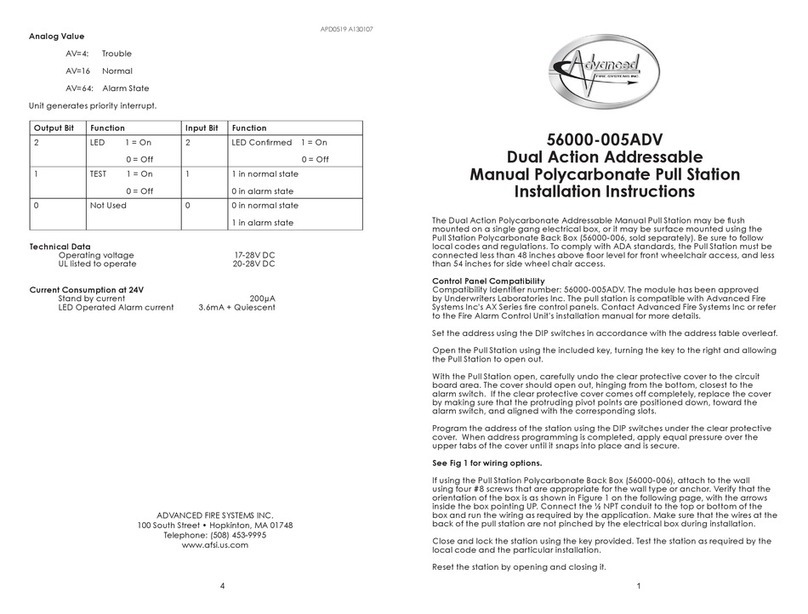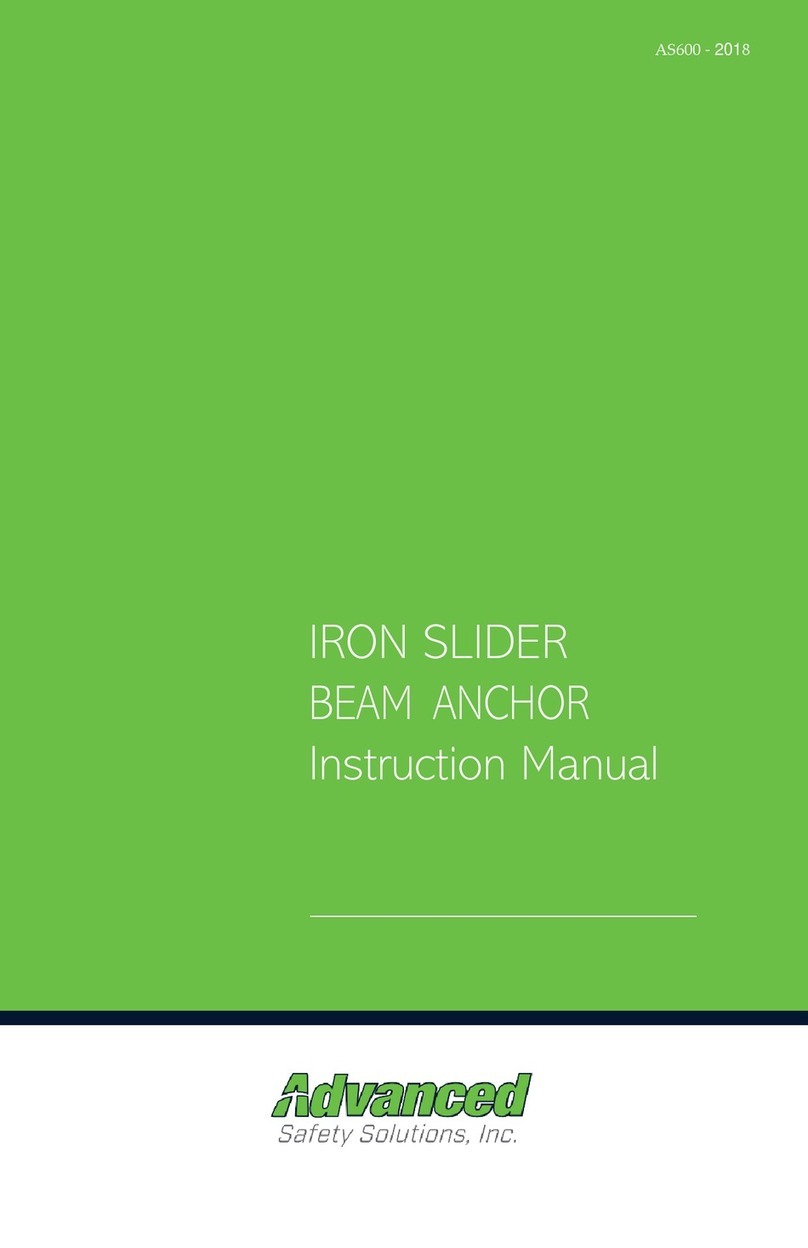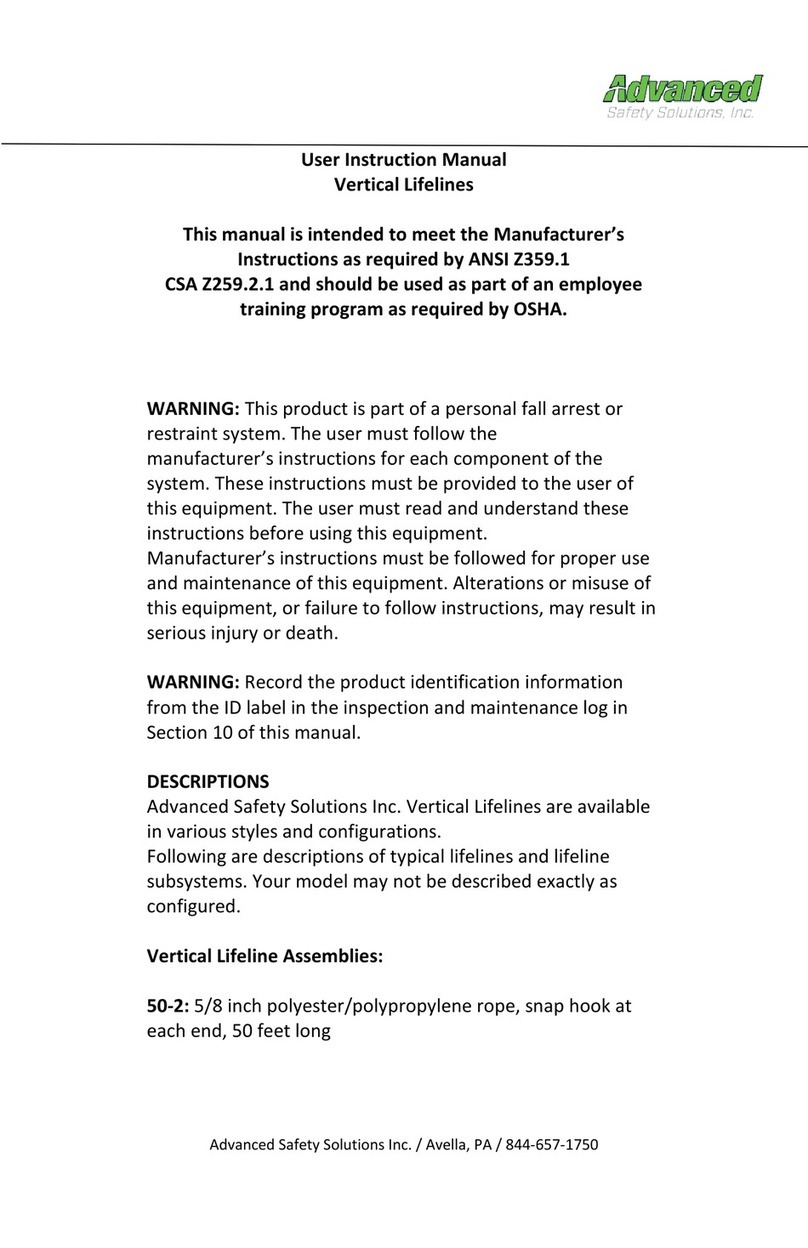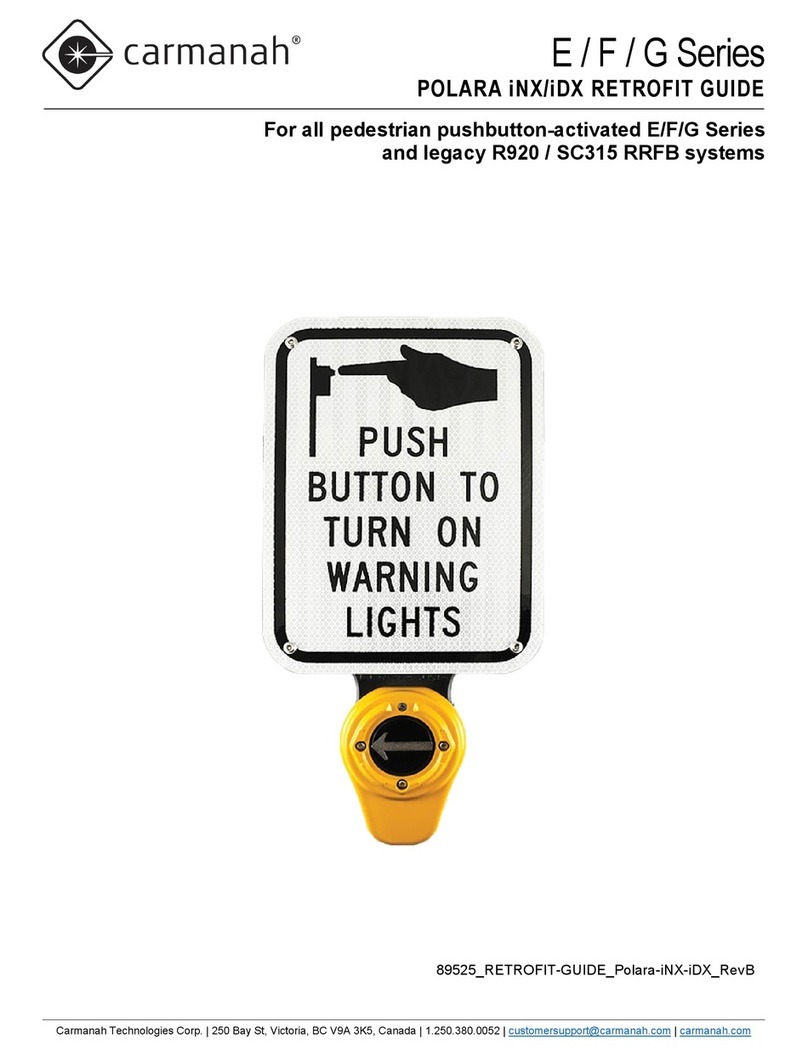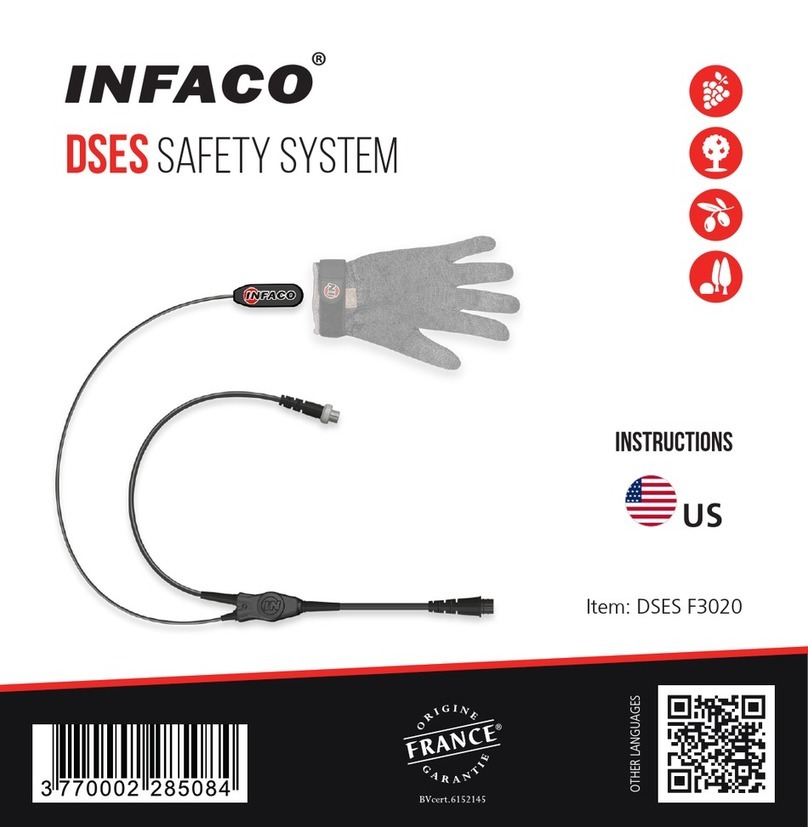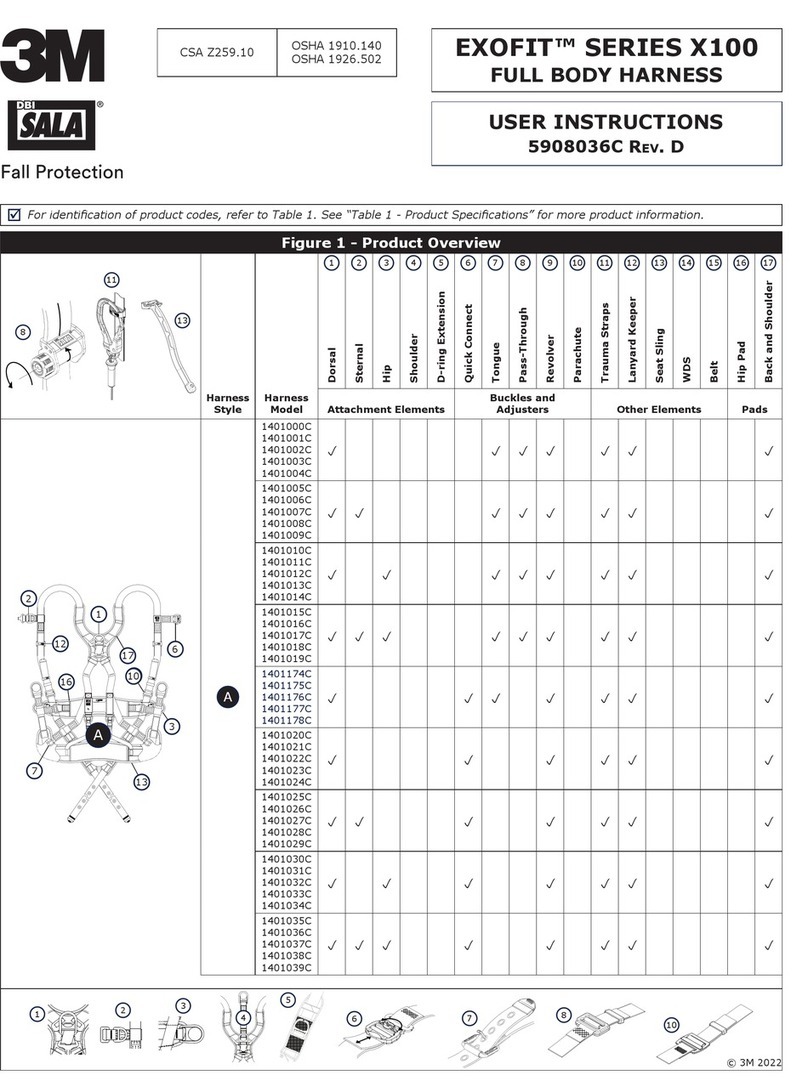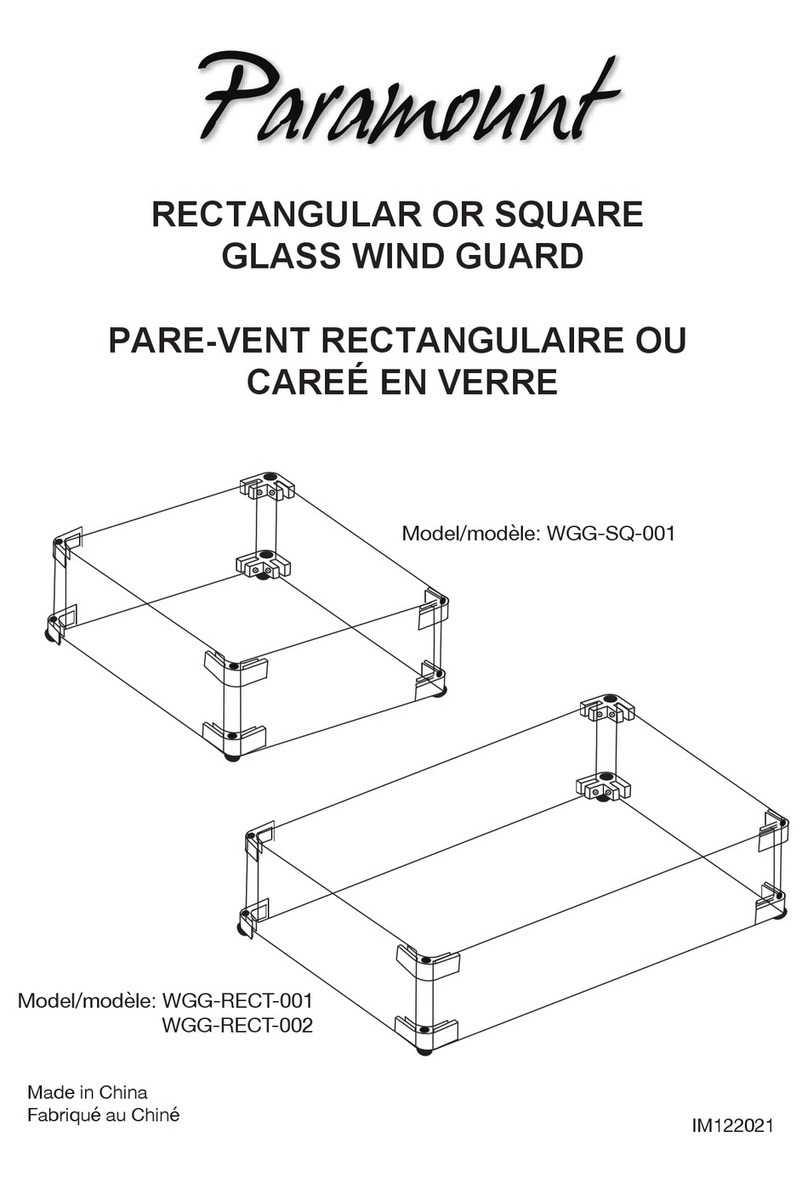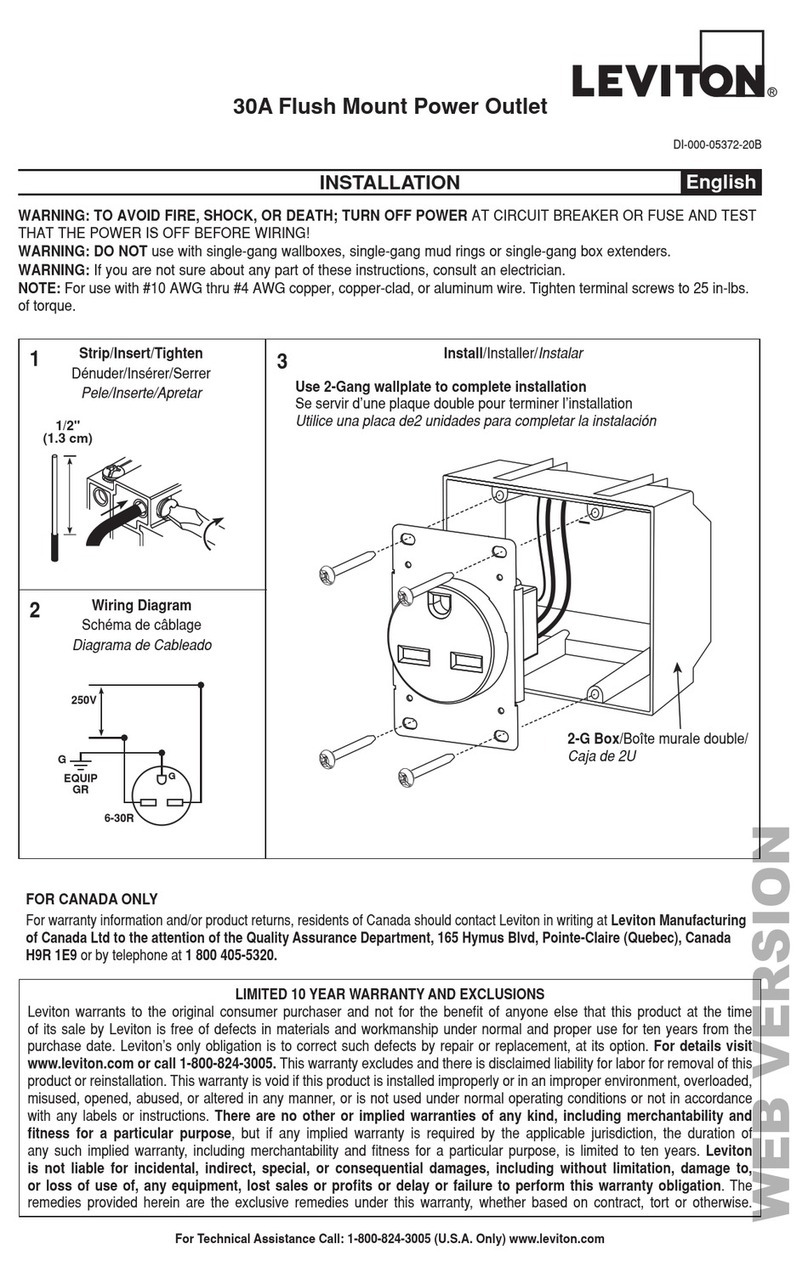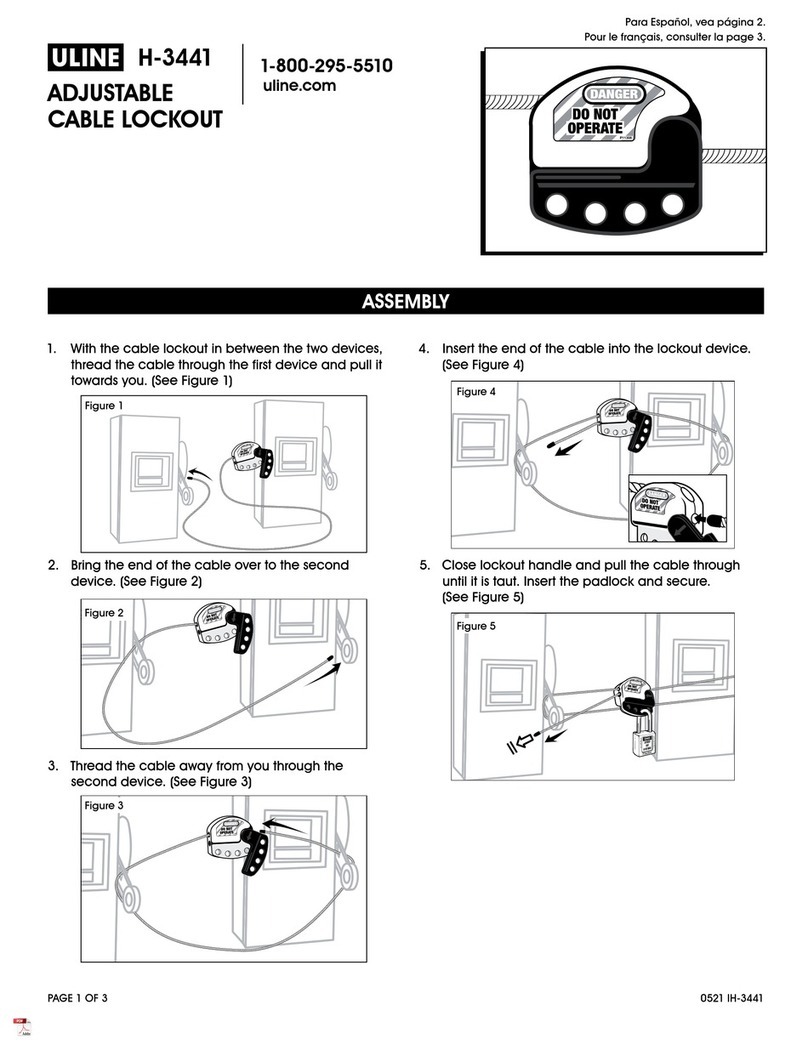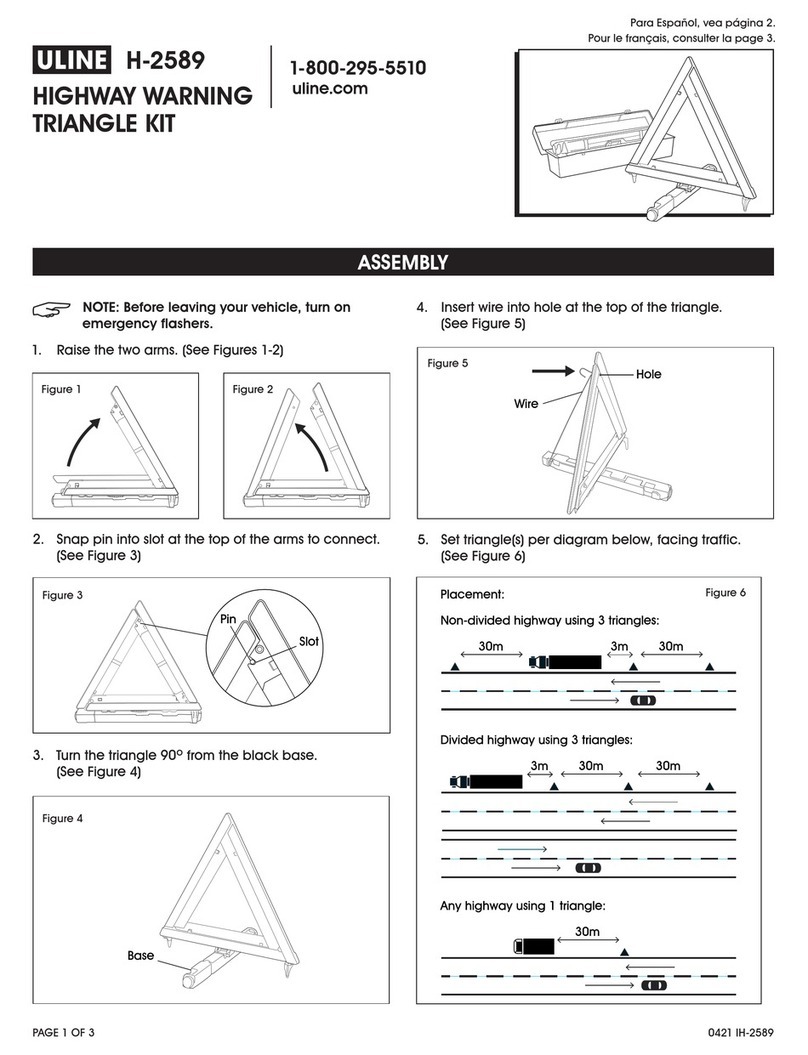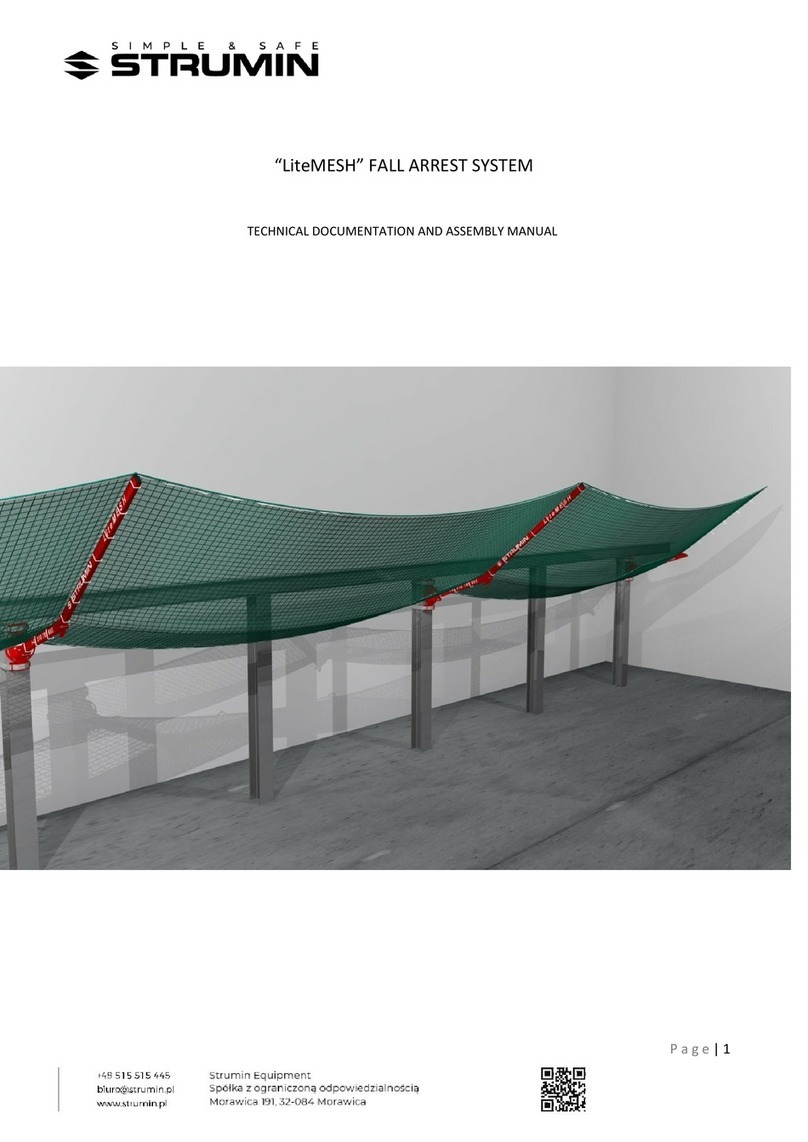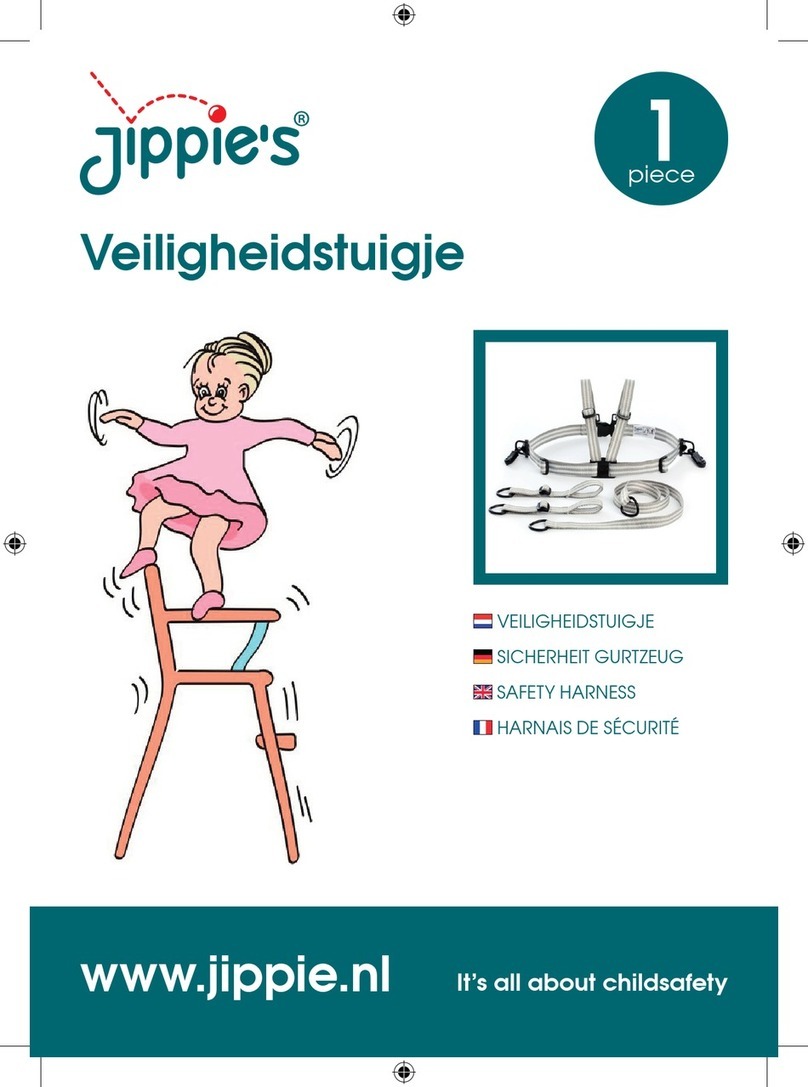Advanced Ansi 9206C-LE Operator's manual

USER INSTRUCTION MANUAL
SHOCK
ABSORBING
LANYARD
9206C-LE
This instruction manual applies to the following model:

This manual must be read and understood in its entirety and used as part of fall protection training program as required by
OSHA or any state regularity agency. These instructions are intended to meet the manufacturer instructions as required by
ANSI/ASSE Z359.13. The user must fully understand the proper equipment use and limitations.
THE INSTRUCTIONS APPLY TO THE FOLLOWING MODELS:
Advanced Safety Solutions Inc. 304, County Park Road, Avella, Pa 15312.
Do not skip this instruction manual. Read the instruction manual carefully before using the equipment. If failed in
doing so it may cause serious injury or Death.
1
Shock Absorbing Leading Edge Cable Lanyard 9206C-LE for 12 ft free fall
SPECIALITY LANYARDS:
A. Leading Edge Lanyards: These type of lanyards particularly meant for providing leading edge protection to the user when
working horizontally near sharp edges specially on terraces, roof tops etc. The models enlisted under it are as follow:
9206C-LE
WARNING: T his product is part of a personal restraint, work positioning, suspension, or rescue system. The user must read
and follow the manufacturer's instructions for each component or part of the complete system. These instructions must be
provided to the user of this equipment. The user must read and understand these instructions or have them explained to
them before using this equipment. Manufacturer's instructions must be followed for proper use and maintenance of this
product. Alterations or misuse of this product or failure to follow instructions may result in serious injury or death.
Figure 1 - Product
1.0 SPECIFIC INSTRUCTIONS :
1.1 Purpose: KARAM lanyards are to be used as part of a personal restraint, work positioning, suspension, or rescue
system. The D-ring extension assembly may also be used as part of a personal fall arrest system only if it is attached to
a self-retracting lifeline or an energy absorbing lanyard. Applications include: inspection work, construction,
demolition, maintenance, oil production, and conned space rescue.
1.2 Maximum Arrest force and Maximum Elongation/Maximum Deployment distance of personal energy absorber when
dynamically tested in accordance with the requirements of ANSI Z359.13 are as follows-
Personal Energy Absorbers
Conditioning: Ambient Dry Ambient Wet Cold Dry Hot Dry
6 ft Free Fall
Max Arrest Force
Average Arrest Force
Max Elongation 48 inches
<=1800 lbs-f
<=900 lbs-f
<=1800 lbs-f
<=1125 lbs-f
48 inches
<=1800 lbs-f
<=1125 lbs-f
48 inches
<=1800 lbs-f
<=1125 lbs-f
48 inches
12 ft Free Fall
Max Arrest Force
Average Arrest Force
Max Elongation
<=1350 lbs-f
<=1800 lbs-f
60 inches
<=1800 lbs-f
<=1575 lbs-f
60 inches
<=1800 lbs-f
<=1575 lbs-f
60 inches
<=1800 lbs-f
<=1575 lbs-f
60 inches

2
2.0 MATERIAL:
All Advance Safety Lanyards have been manufactured by using Polyester/Nylon/Aramid/Steel. The Shock absorbing
lanyards which have been tested for 6 foot free fall have different colour tracer for identication. As against the above,
the lanyards which are tested for 12 foot free fall have different colour tracer for easy distinction. Refer g.2 for applications.
A. Restraint: The lanyard is used to prevent the user from reaching a hazard, such as leading edge work. No vertical
free fall possible.
B. Work Positioning: The lanyard is used to position or support (with a harness or body belt) the user at the work
position, such as window washing or steel workers. Two feet maximum free fall.
C. Suspension: The lanyard (generally a Y-type) is used with a chair or other support system to suspend or transport
the user vertically, such as in a Easy Seat. No vertical free fall possible.
D. Rescue: The lanyard (generally a Y-type) is used to retrieve a victim in a rescue, such as conned space rescue
and retrieval. No vertical free fall possible.
E. Fall Arrest: The D-ring extension is used in-
line with a personal fall arrest system to assist
in attachment to the system.
2.1 Limitations: The following application limitations
must be recognized & considered before using this
product:
A. Capacity: This equipment is for use by
persons with a combined weight (person,
clothing, tools, etc.) within the range of 130
lbs - 310 lbs.
B. Free Fall: Lanyards used for work positioning
applications must be rigged to minimize any
potential vertical free fall. In no case should
the potential free fall be greater than two feet.
For situations where the free fall may exceed two feet, a backup fall arrest system should be used.
I f the D-ring extension assemblies are used in conjunction with a self-retracting lifeline or an energy absorbing
lanyard in a fall arrest application, the length of the D-ring extension assembly must be taken into account when
calculating the free fall distance and the fall clearance requirements.
D. RESCUE
Rescue
Line
Locking
Snap Hook
or karabiner Y-Lanyard
A. RESTRAINT
Lanyard
B. WORK POSITIONING
Lanyard
Backup
Fall Arrest
Option
Self Retracting
Life Line
D-Ring
Extension
E - FALL ARREST
Rescue
Line
D. RESCUE
Locking
Snap Hook
or karabiner Wristlets
Backup
Fall
Arrest
C. SUSPENSION
Line
Note: The fall arrest application is for the D-Ring extension only.
Figure 2 - Applications
Fall Clearance : Always ensure fall clearance distance before using lanyards equipped with the Advance
Safety SHOCK Pack. If there is a risk of fall or if the only anchorage is below the attachment points on the
harness, it is essential to use a lanyard provided with an energy absorber. Before using a shock-absorbing
lanyard, check that there is sufcient f a l l clearance below the user to prevent any collision with the
structure or the ground. See Figure 3.
C.
D. Backup Fall Arrest System: Some applications of this equipment may require the use of a backup fall arrest
system; such as when using a Y- lanyard to suspend a person in a Easy Seat.

3.3 Making Connections: Only use self-locking snap hooks and karabiners with this equipment. Only use connectors that
are suitable to each application. Ensure all connections are compatible in size, shape and strength. Do not use
equipment that is not compatible. Ensure all connectors are fully closed and locked.
Advance Safety connectors (snap hooks and karabiners) are designed to be used only as specied in each product's user's
instructions. See Figure 5 for inappropriate connections.
Advance Safety snap hooks and karabiners should not be connected:
A. To a D-ring to which another connector is attached.
B. In a manner that would result in a load on the gate.
C. In a false engagement, where features that protrude from the
snap hook or karabiner catch on the anchor and without visual
conrmation seems to be fully engaged to the anchor point to
each other.
If the connecting element that a snap hook (shown) or
karabiner attaches to is undersized or irregular in shape, a
situation could occur where the connecting element applies a
force to the gate of the snap hook or karabiner. This force may
cause the gate (of either a self-locking or a non-locking snap
hook) to open, allowing the snap hook or karabiner to
disengage from the connecting point.
Figure 4 - Unintentional Disengagement (roll-out)
2. The gate presses against
the connecting Ring.
3. The gate opens allowing
the snap hook to slip off.
1. Force is applied to the
snap hook.
Small ring or other non-compatibly shaped element
C.
B.
A.
F.E.
D.
G.
Figure 5 - Inappropriate Connections
3
3.0 SYSTEM REQUIREMENTS :
3.1 Compatibility Of Components: Advance Safety equipment is designed for
use with Advance Safety approved components a n d subsystems only .
Substitutions or replacements made with non-approved components or
subsystems may jeopardize compatibility of equipment and may affect the
safety and reliability of the complete system.
E. Physical and Environmental Hazards: Use of this equipment in areas
with physical or environmental hazards may require additional
precautions to reduce the possibility of injury to the user or damage to
the equipment. Hazards may include, but are not limited to; heat,
chemicals, corrosive environments, high voltage power lines, gases,
moving machinery, and sharp edges. Contact Advance Safety if you
have any questions about using this equipment where any
phy s ic a l o r environmental hazards exist.
F. Training: This equipment must be used by persons who have been
properly trained in its correct application and use.
2.2 Refer to applicable local, state, and federal (OSHA) requirements governing
this equipment for more information on lanyards and associated system
components.
Figure 3
Free Fall Distance + Energy-Absorber Deceleration
Distance + Worker height + Safety Factor=20 Ft (6.1M)
Total 19 Ft.
from
Anchorage
Before
3 ft. Safety Factor
6 Ft. Length of
Energy-Absorbing
Lanyard
4 Ft. Deceleration
Distance
6 Ft. of Worker
After
6 Foot free Fall Anchorage
This Application requires
a special EA lanyard
5 Ft. Deceleration
Distance
6 Ft. Length of
Energy-Absorbing
Lanyard
3 Ft. Safety Factor
6 Ft. Height
of Worker
Total
20 Ft.
from
Anchorage
After
Anchorage
Before
12 Foot free Fall Anchorage
Calculating Total Fall Distances:
Total Fall Clearance below worker is calculated
from Anchorage Connection. Free Fall Distance
+ Energy Absorber Deceleration Distance +
Worker height + Safety Factor. Care must be
taken to ensure that the total fall distance is clear
of obstructions, such as equipment, to avoid
contact with a lower level.
Free Fall Distance + Energy Absorber
Deceleration Distance + Worker height +
Safety Factor = 19 Ft. (5.8M)
3.2 Compatibility Of Connectors: Connectors are considered to be compatible
with connecting elements when they have been designed to work togethe r
in such a way that their sizes and shapes do not cause their gate m e chanisms to
inadvertently open regardless of how they become oriented. Contact Advance Safety if you have any questions
about compatibility. Connectors (hooks, karabiners, and D-rings) must be capable of supporting at least 5,000 lbs.
(22.2 kN). Connectors must be compatible with the anchorage or other system components. Do not use equipment
that is not compatible. Non-compatible connectors may unintentionally disengage. See Figure 4. Connectors
must be compatible in size, shape, and strength. Self-locking snap hooks and karabiners are required by ANSI/ASSE
Z359.12 and OSHA.

Typical
Web Lanyard
Typical
Rope Lanyard
Typical Web
Loop Lanyard
Typical D-Ring
Extension Lanyard
Figure 6 - Anchorages
WARNING: Anchorages used for restraint, rescue, or suspension may only be used where there is no possible ver tical free fall. These
anchorages do not have sufcient strength for work positioning or fall arrest. Do not connect work positioning or fall arrest systems to
these anchorages. Anchorages intended for work positioning may not be suitable for use for fall arrest systems (fall greater than two feet)
and should not be used for fall arrest unless specically designed to do so. See Figure 6
NOTE: L arge throat opening snap hooks should not be connected to
standard size D-rings or similar objects which will result in a load on
the gate if the hook or D-ring twists or rotates. Large throat snap
hooks are designed for use on xed structural elements such as rebar
or cross members that are not shaped in a way that can capture the
gate of the hook.
D. Directly to webbing or rope lanyard or tie-back (lanyards
equipped with tie back hook PN 148 are permitted to use
this way).
E. To any object which is shaped or dimensioned such that the snap hook or karabiner will not close and lock, or that
roll-out could occur.
F. To any object which is shaped or dimensioned such that the snap hook or karabiner will not close and lock, or that
roll-out could occur.
4
WARNING: Consult your doctor if there is reason to doubt your tness to safely absorb the shock from a fall arrest. Age
and tness seriously affect a worker's ability to withstand falls. Pregnant women and minors must not use this equipment.
G. Do not use connector on an anchorage object in the manner depicted in picture-G.
H. If using personal shock pack then always attach a connecting lanyard which will make the entire system length not
more than 6ft. Also the connecting lanyard should be ANSI & OSHA compliant & has capacity of 5000lbs at least.
3.4 Max. Arrest Force:
Maximum arrest force for Y shaped lanyard should be limited to 8kN (1800 lbs).
3.5 Anchorage Strength :
The anchorage strength required is dependent on the application type. The following are guidelines for some
application types:
A. Restraint: Anchorages must support a minimum of 3,000 lbs. per person attached.
B. Working Positioning: Anchorages must support at least 3,000 lbs. per person attached; or be designed,
installed, and used under the supervision of a qualied person as part of a complete system, maintaining a safety
factor of at least two.
C. Suspension: Anchorages must support a minimum of 2,500 lbs. per person attached.
D. Rescue: Anchorages must support a minimum of 2,500 lbs. per person attached.
4.0 OPERATION AND USAGE :
WARNING: Do not alter or intentionally misuse this equipment. Consult Advance Safety when using this equipment in
combination with components or subsystems other than those described in this manual. Some subsystem and
c o m p o n e n t combinations may interfere with the operation of this equipment. Use caution when using this equipment
around moving machinery, electrical hazards, chemical hazards, and sharp edges.

4.1 Before Each Use of this equipment, carefully inspect it to assure that it is in
serviceable condition. Check for worn or damaged parts. Ensure that all
hardware is present and secure. Inspect for sharp edges, burrs, cracks, or
corrosion. Ensure self-locking snap hooks or karabiners work properly.
See Figure 7. Inspect the rope or webbing for wear, cuts, burns, frayed
edges, breaks, or other damage. Refer to section 6.0 for further inspection
details. Do not use if inspection reveals an unsafe condition.
4.2 Plan your restraint, working positioning, suspension, or rescue system before starting your work. Consider all factors
that affect your safety at any time during use. The following list gives some important points to consider when planning
your system.
A. Section 2.B. For work positioning systems, the anchorage location must be
selected to limit the free fall to two feet, to reduce swing fall hazards, and to avoid
striking an object during a fall. See Fig. 8.
B. Free Fall: Depending on the lanyard type and the application, the allowable free
fall for 6ft Lanyard, maximum free fall allowed is 6ft and for 12ft Lanyard,
maximum 12ft free fall is allowed. See section 1.2.
C. Fall Clearance: Should a fall occur, there must be sufcient clearance in the fall
area to arrest the fall before striking the ground or other objects.
D. Backup Fall Arrest: Some suspension and work positioning applications of this
equipment may require a backup fall arrest system and independent fall arrest
anchorage. See OSHA guidelines when designing the system.
E. Sharp Edges: Avoid working where the lanyard, subsystem, or other system components will be in contact with,
or abrade against unprotected sharp edges. Do not loop the lanyard around small diameter structural members. If
5
Figure 7 - Hook Operation
Depress locking
mechanism with
index nger
STEP 1
Pull gate back
with thumb
STEP 2
Typical Snap Hook Operation
Rotate
Clockwise
STEP 1
Push
Inward
STEP 2
Typical karabiner Operation
Figure 8 - Swing Fall
Swing Fall
Hazard
working with this equipment near sharp edges is unavoidable, protection against cutting must be provided by
using a heavy pad or other means over the exposed sharp edge.
F. Rescue: Should a fall occur, the user (employer) must have a rescue plan and the means at hand to implement it.
G. After A Fall: Any equipment which has been subjected to the forces of arresting a fall must be removed from
service immediately and destroyed or contact a factory authorized service center for repair.
5.0 TRAINING :
It is the responsibility of all users of this equipment to understand these instructions, and to be trained in the correct
installation, use, and maintenance of this equipment. These individuals must be aware of the consequences of improper
installation or use of this equipment. This user manual is not a substitute for a comprehensive training program. Training
must be provided on a periodic basis to ensure prociency of the users.
WARNING: Follow the manufacturer's instructions for associated equipment (full body harness, work seat, etc.) used in
your restraint, work positioning, suspension, or rescue system.
IMPORTANT:
Training must be conducted without exposing the trainee to a fall hazard. Training should be repeated periodically.
6.0 INSPECTION
6.1 Frequency:
è Before each use visually inspect the equipment.
è The lanyard must be inspected by a competent person other than the user preferably every six month or at least
annually. See section 6.2 for guidelines. Record the results of each inspection in the inspection log in section 10.0.

6.2 Inspection Steps:
6.2.1 Inspection criteria for the equipment shall be set by the user's organization and the inspection criteria shall equal
or exceed the criteria established by the standard ANSI/ASSE Z359.13 or the manufacturer's instructions.
6.2.2 Inspection criteria shall include
è Absence or illegibility of markings.
è Absence of any elements affecting the equipment form, t or function
è Inspect the lanyard hardware (snap hooks, adjusters, thimbles, spreader bar, etc.). T hese items must not be
damaged, broken, distorted, or have any sharp edges, burrs, cracks, worn parts, or corrosion. Ensure the
connecting hooks work properly. The hook gates must move freely and lock upon closing. Ensure the adjusters, if
present, work properly.
è Inspect the webbing. The material must be free of frayed, cut, or broken bers. Check for tears, abrasions, mold,
burns, or discoloration. Inspect the stitching. Check for pulled or cut stitches.
è The webbing must be free of knots, excessive soiling, heavy paint buildup, and rust staining. Check for chemical or
heat damage, indicated by brown, discolored, or brittle areas. Check for ultraviolet damage, indicated by
discoloration and the presence of splinters or slivers on the webbing surface. All of these above factors are known
to reduce the webbing strength. Damaged or questionable webbing should be replaced.
6.3 Inspect the labels. All labels must be present and fully legible. See section 8.0.
6
IMPORTANT: If this equipment has been subjected to forces resulting from the arrest of a fall, it must be immediately
removed from service and destroyed or returned to Advance Safety for possible repair. See section 6.2. for
inspe c t i n g the equipment. Extreme working conditions (harsh environment, prolonged use, etc.) may require increasing
the frequency of inspections.
6.4 Record the inspection date and results on the inspection log. See section 10.0.
6.5 If inspection reveals a defective condition, remove the unit from service immediately and destroy, or contact a factory
authorized service center for repair.
IMPORTANT: Only Advance Safety or parties authorized in writing may make repairs to this equipment.
7.0 MAINTENANCE - SERVICING – STORAGE :
7.1 Clean the lanyard with water and a mild detergent solution. Wipe the hardware off with a clean, dry cloth, and hang it to
air dry. Do not force dry with heat. If you have any questions regarding the cleaning of this equipment, or require more
information contact Advance Safety. An excessive buildup of dirt, paint, etc., may prevent the lanyard from working
properly, and in severe cases degrade the webbing to a point where it has become weakened and should be
removed fro m service. If you have any questions concerning the condition of your lanyard, or have any doubt about
putting it into service, contact Advance Safety.
7.2 Additional maintenance and servicing procedures (i.e. replacement parts) must be completed by a factory authorized
service center. Authorization must be in writing.
7.3 Equipment which is in need of or scheduled for maintenance shall be tagged as “unusable” and removed from service.
7.4 Store the lanyard in a cool, dry, clean environment out of direct sunlight. Avoid areas where chemical vapors may exist.
Thoroughly inspect the lanyard after extended storage.

7
7.5 Inspection & maintenance log.
8.0 LABELING & GENERAL MARKING REQUIREMENTS :
8.1 Markings are provided in English
8.2 The legibility and attachment of required markings shall endure for the life of the component, subsystem or system
being marked.
8.3 Equipment shall be marked with the following:
è Part no and model designation
è Month and Year of manufacture
è Manufacture name or logo
è Capacity rating
è Serial number
è Standard number
è Manufacturer's instructions for the use of equipment and warnings to be followed to avoid contact with sharp
edges, abrasive surfaces and need to make only compatible connections.
è Material of construction
YR J F M A M J J A S O N D
USER MUST INSPECT BEFORE EACH USE.
Competent Person to inspect and initial
at least every 6 months.
Date of First Use (please complete) __________________
è Length of equipment
è Maximum elongation, maximum arrest force, average arrest force, maximum free fall distance
è 6 ft Free fall personal energy absorber is marked in Black print on a contrasting white background with text fonts
compliance to standards
è 12 ft Free fall personal energy absorber is marked in white print on a contrasting black background with text fonts
compliance to standards

8
8.4 Y Lanyard (6ft. & 12ft.) free fall carry a dynamic hip test failure warning label on both connecting ends instructing users
to safely store the unused leg of lanyard.
9.0 MATERIAL OF CONSTRUCTION OF ENERGY ABSORBING LANYARD :
9.1 Lanyard is made of high tenacity Polyester yarn/Nylon/Steel/Aramid.
9.2 Energy absorber attached to the lanyard is made of Polyamide webbing with Polyester/Aramid back up strap.
HOW TO DISPOSE A LANYARD:
When the lanyard becomes unts or in case of any wear and tear, dispose the lanyard immediately.
Warning: User must ensure that unused Leg of the Y lanyard is safely stored and it does not cause obstruction.
FOLLOW THE STEPS FOR DISPOSAL:
n Make the three plastic crates namely- Textile, Metal & Plastic for placing the respective components of the lanyard.
n Spread the lanyard on a table / at surface.
n Inspect the wear & tear present on the lanyard.
n If any wear and tear is observed, dispose the lanyard using a sharp scissor; rst cut the Textile and dismantle the
lanyard.
n Put the Textile, Plastic & Metal components in their respective plastic crates.
DISCLAIMER:
This information on the product is based upon technical data that Advance Safety obtained under laboratory conditions
and believes to be reliable. Advance Safety does not guarantee results and take no liability or obligation in connection
with this information. As conditions of end use are beyond our control it is the user's responsibility to determine the
hazard levels and the use of proper personal protective equipment. Persons having technical expertise should undertake
evaluatio n under their own specic end-use conditions, at their own discretion and risk. Please ensure that this information
is only used to check that the product selected is suitable for the intended use. Any product that is damaged, torn worn
or punctured should be discontinued from usage immediately.

9

EQUIPMENT RECORD
Product :
Model & type/identication
Manufacturer
Year of manufacture
Other relevant information (e.g. Document number)
PERIODIC EXAMINATION AND REPAIR HISTORY
Date Reason for entry
(periodic examination
or repair)
Defects noted, repairs
carried out and other
relevant information
Name and signature
of competent user
Periodic examination
next due date
Trade name Identication number
Address Tel, fax, email into use
Purchase date Date rst put into use
Advanced Safety Solutions Inc. 304, County Park Road, Avella, Pa 15312.
Table of contents
Other Advanced Safety Equipment manuals
